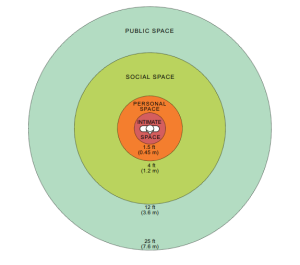3.11 Types of Nonverbal Communication
[Author removed at request of original publisher]; Manon Allard-Kropp; and Linda Macdonald
Learning Objectives
By the end of this chapter, you should be able to
- Describe the eight general types of nonverbal communication
- Explain the impacts of these nonverbal types of communications
Chapter 3.10 discussed the general principles that apply to nonverbal communication. This chapter discusses types of nonverbal communication and how you can manage them in presentations and social contexts.
Space
When we discuss space in a nonverbal context, we mean the space between objects and people. Space is often associated with social rank and is an important part of business communication.
Edward T. Hall (1963) noticed that people in different countries kept different distances from each other. In France, they stood closer to each other than they did in England. Hall wondered why that was and began to study what he called proxemics, or the study of the human use of space and distance in communication (Hall, 1963). Expectations of distance vary greatly by culture. From how close you stand to others in a cafeteria line to where you place your backpack in class to how many people you cram into an elevator, your personal expectations of space are often at variance with others.
In The Hidden Dimension (Hall, 1966), Hall indicated there are two main aspects of space: territory and personal space. Hall noted that the more powerful person often claims more space. This occupation of space plays an important role in modern society, from who gets the corner office to who sits at the head table at a conference dinner.
Territory is related to control. As a way of establishing control over your own room, you may have  painted it or put up posters that represent your interests or things you consider unique about yourself. Families or households often mark their space by putting up fences or walls around their houses. This sense of a right to control your space is implicit in territory. Territory means the space you claim as your own, are responsible for, or are willing to defend.
painted it or put up posters that represent your interests or things you consider unique about yourself. Families or households often mark their space by putting up fences or walls around their houses. This sense of a right to control your space is implicit in territory. Territory means the space you claim as your own, are responsible for, or are willing to defend.
The second aspect Hall highlights is personal space, or the “bubble” of space surrounding each individual. Distance between people varies depending on their relationship. Hall (1966) identified four categories of interpersonal distances, as shown in Figure 3.11.1. In North America, intimate distance ranges from touch to half a metre (about 1.5 feet). Personal or casual distances between friends and colleagues range from half a metre to just over a metre. Social space, used with acquaintances, is typically 1.2 to 3.6 metres, with the minimum for social distance during the pandemic extended to 2 metres. Public distances (speaking from a podium, for example) are greater than 4 metres (12 feet).
Figure 3.11.1
Space: Four Main Categories of Distance

Proxemics can vary by culture, gender, social setting, and individual preference. For example, in Canadian grocery stores, it is considered polite to leave the person in front of you in line plenty of personal space. In China, however, due in large part to its denser population, it is common to leave less than a two-foot gap between you and the person in front of you in line. The pandemic heightened our awareness of space. During the pandemic, our personal space bubbles were enlarged. Violations of this space were considered a violation of social etiquette as well as a threat to health.
Speaking in a public space carries certain expectations. The speaker occupies a space on the “stage,” even if it’s in front of the class. When you occupy that space, the audience will expect you to behave in certain ways. If you talk to the screen behind you while displaying a PowerPoint presentation, the audience may think you are not paying attention to them. Speakers are expected to pay attention to and interact with the audience, even if the connection is primarily nonverbal. Your use of the space should coordinate with the tone, rhythm, and content of your speech. Stepping further away from the audience or pacing back and forth can detract from your speech. In contrast, moving toward the audience can create a more intimate connection. Moving forward reduces the interpersonal distance and gives the impression of moving from a public to a social realm.
Time
Chronemics is a field of study examining the utilization of time in nonverbal communication. Perceptions of time can play significant roles in various forms of nonverbal communication. For example, a slight pause before finishing an announcement can help to build a sense of anticipation in one’s audience. Aside from the transmission of mood, time can also figure into communication in terms of attention span and the expression or reinforcement of power relationships. A culture’s perception of time not only influences the way they communicate but also the way they organize and execute their daily lives. Cultures are generally divided into two main groups based on the way that members of that culture generally perceive time: monochronic cultures and polychronic cultures.
Monochronic cultures are societies made up of people that appreciate doing one task at a time without interruption or tardiness. People in these cultures tend to believe that time is linear. The contemporary United States and Canada are monochronic cultures. In these cultures, people tend to keep very rigid schedules and usually value punctuality, brevity, and adherence to plans made in advance. In the U.S., time is viewed as a resource, as is illustrated by the common expression “time is money.” People living in  monochronic cultures tend to focus on the completion of one task at a time and usually view interruption and distraction as things to be avoided. Monochronic cultures like the U.S. look down upon being late. When there is a schedule and it is not followed, there are often consequences and social respect is sometimes lost.
monochronic cultures tend to focus on the completion of one task at a time and usually view interruption and distraction as things to be avoided. Monochronic cultures like the U.S. look down upon being late. When there is a schedule and it is not followed, there are often consequences and social respect is sometimes lost.
Polychronic cultures tend to see time as fluid and malleable. Characteristics of polychronic cultures include interrupted meetings, flexible schedules, and higher values placed on people and relationships over punctuality and deadlines. Examples of polychronic cultures are those found in modern Mexico and Egypt. People of these cultures tend to keep open schedules, often altering plans without notice and “double-booking” themselves. In monochronic cultures such as the United States, Germany, and Great Britain, these behaviors are thought to be inefficient and improper. People of polychronic cultures are more open to distractions and interruption but are better at focusing on many tasks at once. Polychrons prefer to keep their time unstructured, changing from one activity to another as the mood takes them. Although polychrons can meet deadlines, they need to do so in their own way. A polychron does not want detailed plans imposed upon him, nor does he want to make his own detailed plans. Polychrons prefer to work as they see fit without a strict schedule, following their internal mental processes from one minute to the next. This view of time conflicts with expectations in a settler Canadian workplace, and variations in cultural views of time may impact the workplace environment.
In North American settler cultures, time is a relevant factor in your presentation. The best way to show your audience respect is to honour the time expectation associated with your speech. Plan your speech to fit within the designated time. Stop speaking before the audience stops listening; if the audience thinks that you have gone over time, they will be less willing to listen, which will have a negative impact on your ability to communicate your message. If you are delivering a speech with three main points, your audience expects you to regulate the time and attention to each point, but if you spend all your time on the first two points and rush through the third, your speech won’t be balanced and will lose rhythm. The logical flow and your credibility will be threatened.
Physical Characteristics
You didn’t choose your eye colour, the natural colour of your hair, your height, your gender, or your skin colour, yet judgments about personality or behaviour are often made based on physical characteristics. These judgments are often inaccurate and may be the result of implicit or explicit bias. You cannot control your audience’s assumptions based on your physical characteristics.
Regardless of your gender or hair colour or how tall you are, being comfortable with yourself is an important part of your presentation. Act naturally and consider aspects of your presentation you can control in order to maximize a positive image for the audience.
Body Movements
The study of body movements, called kinesics, is key to understanding nonverbal communication. Since your actions will significantly contribute to the effectiveness of your business interactions, let’s examine four distinct ways that body movements complement, repeat, regulate, or replace your verbal messages.
Body movements can complement the verbal message by reinforcing the main idea. For example, you may be providing an orientation presentation to a customer about a software program. As you say, “Click on this tab,” you may also initiate that action. Your verbal and nonverbal messages reinforce each other. You can also reinforce the message by repeating it. If you first say, “Click on the tab,” and then motion with your hand to the right, indicating that the customer should move the cursor arrow with the mouse to the tab, your repetition can help the listener understand the message.
In addition to repeating your message, body movements can also regulate conversations. Nodding your head to indicate that you are listening may encourage the customer to continue asking questions. Holding your hand up with the palm out may signal them to stop and provide a pause where you can start to answer.
Body movements also substitute or replace verbal messages. Researchers found that facial features communicate to others our feelings, but our body movements often reveal how intensely we experience those feelings (Ekman & Friesen, 1967). For example, if the customer makes a face of frustration while trying to use the software program, they may need assistance. If they push away from the computer and separate themselves physically from interacting with it, they may be extremely frustrated. Learning to gauge feelings and their intensity as expressed by customers takes time and patience, and your attention to them will improve your ability to facilitate positive interactions.
As a general rule when presenting, try to act naturally, as if you were telling a friend a story, so that your body will relax and your nonverbal gestures will come more naturally. Practice is key to your level of comfort; the more practice you get, the more comfortable and less intimidating it will seem to you.
Touch
Before giving your presentation, you may interact with people by shaking hands (often replaced in the post-pandemic era with placing your hand on your heart or slightly bowing your head) and making casual conversation. This interaction can help establish trust before you present. While speaking in a large public setting we do not often touch people in the audience, but we do interact with visual aids, our note cards, and other objects. How we handle them can communicate our comfort level. It is always a good idea to practice using the technology, visual aids, or note cards you will use in a speech during a practice session. Using the technology correctly by clicking the right button on the mouse or pressing the right switch on the overhead projector can contribute to your credibility.
Paralanguage
Paralanguage is the exception to the definition of nonverbal communication. We defined nonverbal communication as not involving words, but paralanguage exists when we are speaking. Paralanguage involves verbal and nonverbal aspects of speech that influence meaning and includes tone, intensity, pausing, and even silence.
Perhaps you’ve heard of a “pregnant pause”, a silence between verbal messages that is full of meaning. For example, your coworker Jan comes back from a sales meeting speechless and with a dazed look. You may ask if the meeting went all right. “Well, ahh…” may be the only response you get. The pause speaks volumes. Something happened, though you may not know what. It could be personal if Jan’s report was not well received, or it could be more systemic, like the news that sales figures are off by 40 percent and layoffs may not be far behind.
Silence or vocal pauses can communicate hesitation, indicate the need to gather thought, or serve as a sign of respect. Keith Basso quotes an anonymous source as stating, “It is not the case that a man who is silent says nothing” (Basso, 1970). Sometimes we learn just as much, or even more, from what a person does not say as what they do say. In his book Gather (2021), Richard Van Camp writes that he uses silence in storytelling for effect and to capture the listeners’ attention. He says, “People who hear me share, know I take my time telling a story, giving it the time and dignity it deserves” (p. 114).
Artifacts
 Artifacts are forms of decorative ornamentation that are chosen to represent self-concept. They include tattoos, facial piercings, dyed hair, and other body modifications as well as, for example, clothes, watches, briefcases, purses, eyeglasses, and branded merchandise.
Artifacts are forms of decorative ornamentation that are chosen to represent self-concept. They include tattoos, facial piercings, dyed hair, and other body modifications as well as, for example, clothes, watches, briefcases, purses, eyeglasses, and branded merchandise.
What we choose to surround ourselves with communicates something about our sense of self. They may project gender, role or position, class or status, personality, and group membership or affiliation. Paying attention to a customer’s artifacts can give you a sense of the self they want to communicate and may allow you to more accurately adapt your message to meet their needs. Potential employers or colleagues may also use artifacts to determine your sense of self.
Do you cover your tattoos when you are at work? Do you know someone who does? In your line of work, a tattoo might be an important visual aid, or it might detract from your effectiveness as a business communicator. Body piercings may express individuality, but you need to consider how they will be interpreted by employers and customers.
The employer industry, company culture, and stakeholder expectations influence the acceptability of artifacts in the workplace. Employers are increasingly viewing tattoos, dyed hair, and facial piercings as acceptable expressions of individuality. Gen Z brings into the workplace more casual and individualized looks, and employers are adapting to these trends. Indeed’s Editorial Team (2021) states that employers may accept tattoos to affirm employees’ individuality, to appeal to some clients’ aesthetic sense, to promote diversity, and to inspire creativity. Hotson (2020), however, found that more conservative industries, including financial services and banking, are at the conservative end of the sliding scale of acceptability. Understanding the boundaries of self-expression in your field of work will ensure that your artifacts reflect company values rather than conflict with existing policy and standards.
Environment
Environment involves the physical and psychological aspects of the communication context. More than the tables and chairs in an office, environment is an important part of the dynamic communication process. The perception of one’s environment influences one’s reaction to it. For example, Google is famous for its work environment, with spaces created for physical activity and even in-house food service around the clock. The expense is no doubt considerable, but Google’s environment creates value by facilitating the creativity, interaction, and collaboration that define the company’s success.
Check Your Knowledge (7 Questions)
References
Basso, K. A. (1970). To give up on words: Silence in western Apache culture. In D. Carbaugh (Ed.), Cultural communication and intercultural contact (pp. 301–318). Hillsdale, NJ: Laurence Erlbaum.
Bruneau, T. (1974). Time and nonverbal communication. Journal of Poplular Culture, 8, 658–666.
Bruneau, T. (1990). Chronemics: The study of time in human interaction. In J. DeVito & M. Hecht (Eds.), The nonverbal reader (pp. 301–311). Prospect Heights, IL: Waveland Press.
Bruneau, T., & Ishii, S. (1988). Communicative silence: East and west. World Communication, 17, 1–33.
Burnham, T., & Phelan, J. (2000). Mean genes: From sex to money to food: Taming our primal instincts. Cambridge, MA: Perseus.
Cash, T., & Kilcullen, R. (1985). The eye of the beholder: Susceptibility to sexism and beautyism in the evaluation of managerial applicants. Journal of Applied Social Psychology, 15, 591–605.
Ekman, P., & Friesen, W. (1967). Head and body cures in the judgment of emotions: A reformulation. Perceptual and Motor Skills, 24, 711–724.
Hall, E. (1966). The hidden dimension. New York, NY: Doubleday.
Hall, E. T. (1963). Proxemics: The study of man’s spacial relations and boundaries. In Iago Galdston (Ed.), Man’s image in medicine and anthropology (pp. 422–445). New York, NY: International Universities Press.
Hotson, E. (2020, January 13). How workplaces are phasing out the tattoo stigma. BBC. https://www.bbc.com/worklife/article/20200113-normalising-the-workplace-tattoo-taboo
Indeed Editorial Team, (2021, February 22). Your guide to tattoos in the workplace. https://www.indeed.com/career-advice/starting-new-job/tattoos-in-a-workplace
Kinsman, M. (2001, August 20). Tattoos and nose rings. San Diego Union-Tribune, p. C1.
McLean, S. (1998). Turn-taking and the extended pause: A study of interpersonal communication styles across generations on the Warm Springs Indian reservation. In K. S. Sitaram & M. Prosser (Eds.), Civic discourse: Multiculturalsim, cultural diversity, and global communication (pp. 213–227). Stamford, CT: Ablex Publishing Company.
Philips, S. (1983). The invisible culture: Communication in the classroom and community on the Warm Springs Indian Reservation. Chicago, IL: Waveland Press.
Schwartz, T. (1989, January/February). Acceleration syndrome: Does everyone live in the fast lane? Utne Reader, 31, 36–43.
Seiler, W., & Beall, M. (2000). Communication: Making connections (4th ed.). Boston, MA: Allyn & Bacon.
Van Camp, R. (2021). Gather: On the joy of storytelling. University of Regina Press.
Figure 3.11.1 from 2.1: Theory of Non-Verbal Communication- Important Concepts licensed under CC BY-NC-SA 4.0 by Manon Allard-Kropp

